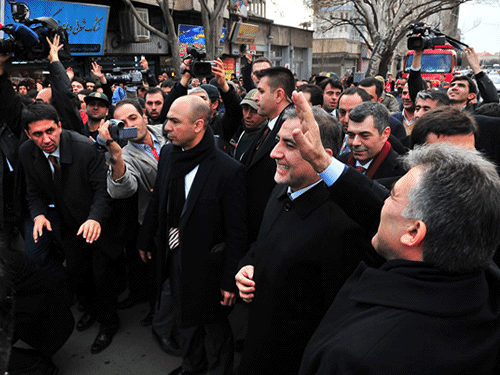Iran Exclusive

Arriving in the historical city of Tabriz, where the majority of the population are Azeri Turks, after completing his schedule in Isfahan, President Gül enjoyed great enthusiasm by the people of Tabriz.
The President was welcomed by the East Azerbaijan Province Governor, Ahmad Alireza Beigi, Turkey’s Consul General to Tabriz, Yunus Belet and other officials at Tabriz Airport. He was later presented with a silk rug with a verse from the Koran on it by the Governor of the Eastern Azerbaijan Province, Ahmet Ali Rıza Beydi. He also attended the dinner given by the governor.
GÜL’S VISITS TO TABRIZ’S HISTORICAL PLACES
Further exploring the Constitutional House of Tabriz, Masjid-i Kabud and the Museum of Azerbaijan, President Gül, on his way to the downtown, enjoyed great interest and love from the people of Tabriz, chanting slogans: “Long live Turkey!”
PRESIDENT WITH TURKISH EXPATRIATES IN TABRIZ
President Gül, as part of his last program in Tabriz, met with Turkish expatriates during a reception given by the Turkish Consul general to Tabriz, Yunus Belet.
The President addressed the Turkish expatriates at the reception and expressed his happiness to be with them, informing them of his programs in Tehran.
HISTORIC RELATIONS BETWEEN TURKEY AND TABRIZ
Noting that Tabriz is a great city with historic relations with Turkey, the President referred to Turkey’s Consulate General which was opened back in 1921, adding his pleasure at observing the great enthusiasm he received from the people of Tabriz.
Having completed his schedule in the Republic of Iran, President Gül left for Ankara.
MUSEUM OF AZERBAIJAN

Located adjacent to Masjid-i Kabud in the city center, the 3-storey Museum of Azerbaijan was opened in April, 1958 and renovated in 1962. On the top storey are the works belonging to the Persian, Seljuk, Safavid and Iranian civilizations; on the ground floor are the findings as old as 4,000 years, most of which were found in Azerbaijan. As for the basement, the museum displays the sculptures by Tabrizian Ahad Huseyni symbolizing with his modern understanding today’s world and menaces posed against humanity.
GOK MASJID (MASJID-I KABUD)

The masjid, built by the Turkoman Sultan Muzafaraddin Shah Jahan (1436-1467), is known for its blue chine within and thus named Gok (Blue) Masjid or the Islamic Turquoise as well.
THE BAZAAR OF TABRIZ

One of the most important commercial centers on the Silk Road, the Tabriz Historic Bazaar has a series of interconnected, covered, brick structures, buildings, and enclosed spaces for different functions. Tabriz and its Bazaar were already prosperous and famous in the 13th century when the town became the capital city of the Safavid Empire. The city lost its position as capital in the 16th century, but remained significant as a trade hub up to the end of the 18th century, with the expansion of Ottoman power. It is one of the most complete examples of the traditional commercial and cultural system of Iran.
CONSTITUTION HOUSE OF TABRIZ

Constructed in 1868 by Haj Vali Me'mar-e Tabrizi, the Constitution House of Tabriz, located next to the Bazaar of Tabriz, was built during the years which led to Constitutional Revolution and afterwards it was used as a place to convene for leaders, activists and sympathizers of the movement among whom were Sattar Khan, Bagher Khan, Seqat-ol-Eslam Tabrizi and Haji Mirza Aqa Farshi. This two-storey building has a number of rooms and halls. The most beautiful part of the house is a skylight and corridor decorated with colorful glass and mirrors. The house converted into a museum includes sculptures and personal belongings of famous constitution revolutionaries.







































